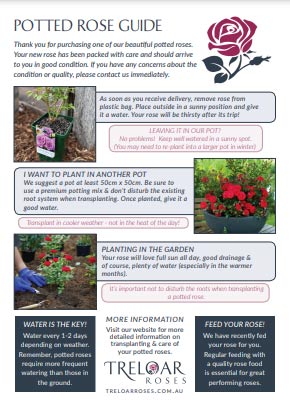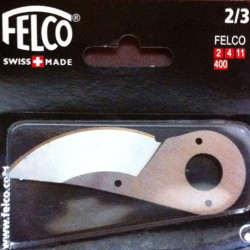Caring For Potted Roses
Printable Potted Rose Care Guide:
To download our printable Potted Rose Guide click here

Rose Type:
Smaller growing roses tend to perform better in pots, as they have smaller root systems. Roses such as miniatures, ground covers and small growing floribundas are ideal. Selecting a rose with a height of 1.2m at the most and the plant will live happily in a pot.
Pot Size:
The ideal pot size will depend on the type of rose you are planting. Larger roses will need larger pots. Generally, for average sized roses we recommend a pot 50cm x 50cm.
Ensure the pot has good drainage.
Potting Mix:
A good quality premium potting mix is ideal.
We always recommend testing the pH of the potting mix before use as even the top-quality mixes can be out of the ideal range of 6.5-7. Testing kits are easy to use at home.
Planting in the pot:
When planting a rose in the pot, it should be positioned so that it is in the centre of the pot. You should also be able to plant the rose so that the soil line is 2.5cm below the graft. If you find either is not possible and the roots are to big, firstly check your pot size. If correct then you can trim the thick roots to size but try to leave the fine feeder hair roots.
The potting mix should be filled up right to the top of the pot. It will settle to just under the lip of the pot.
To avoid issues with your roses, we recommend only planting one rose per pot.
Where to position the pot in your garden:
Pots provide the roots with little insulation. This means that the roots are not well protected from the external environment and can easily be affected by the heat. Therefore, positioning your potted rose correctly is important.
Roses need 6 hours of direct sunlight but if your climate is hot, then they may need to be moved into some shade during the midday heat. A pot trolley is a great addition to help in moving them.
Avoid positioning next to brick, tin, stone, concrete, or any surface that radiates heat. This is especially important in summer or hot climates.
Watering potted roses:
Potted roses require watering daily as pots provide the roots with little insulation from the sun. The potting mix can dry out quickly and the plants become dehydrated and scorched.
Provide enough water that it starts to run out the bottom of the pot.
Ensure pots are well drained.
Never sit your potted roses in a saucer but instead allow the water to drain away.
Mulch:
We recommend putting a layer of mulch over the top of the pot. This will help the soil retain moisture and help keep the temperature down.
Avoid stones or pebbles.
See our mulching guide for more information, click here.
Fertiliser:
Fertilise as normal. See our fertilising guide for more information, click here.
Pruning:
Prune your rose as normal. See our pruning guide for more information, click here.
Out growing the pot:
Roses naturally have large root systems and can often outgrow their pot. This can happen if the pot is too small or your plant has been in the pot for several years.
When a rose becomes pot bound the growth will become less vigorous and we can begin seeing discoloured foliage. Overall, the rose will begin looking sick.
We recommend waiting until winter when the plant is dormant to fix the issue. Give the rose a good winter prune and remove it from the pot and place in a bucket of water.
If you are planting into a bigger pot, just plant it as normal with fresh potting mix.
If a larger pot is not possible, give the roots a small prune. Re-plant with fresh potting mix.






